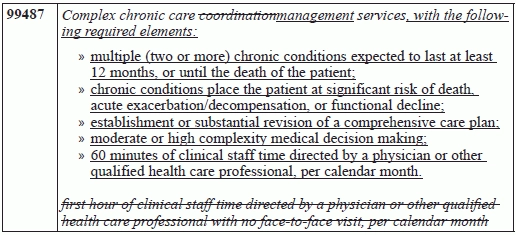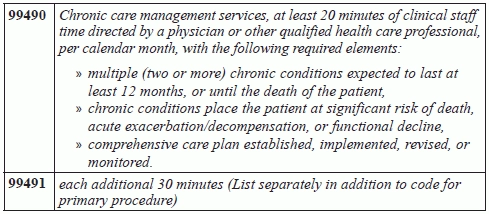Look for Revised, Updated Chronic Care Management Codes in January

Plus: You’ll find new flu shot coding options.
Although 2015 might sound rather far away, the fact is that January will soon be creeping up on us—and with the new year come new CPT® codes to keep your practice billing accurately. Although the American Medical Association just released the new codes, we’ve got a sneak peek at several that will impact your Part B practice.
CCM Already Updated
You might just be getting to know the complex chronic care coordination code 99487, which CPT® introduced in 2013, but it’s already getting a facelift. CPT® has changed the title to complex chronic care management, deleted one add-on code in the series, and also debuted several companion codes. The following changes will be relevant to any physician who manages patients with chronic problems:
Revised (the changes are emphasized below)
You’ll note that 99488 (…first hour of clinical staff time directed by a physician or other qualified health care professional with one face-to-face visit, per calendar month) has been deleted completely, and 99489 (...each additional 30 minutes of clinical staff time directed by a physician or other qualified health care professional, per calendar month) is the same as it was in the past.
The updates reflect the stringent requirements that you must meet to bill these codes. Now the descriptor clearly states what is required, such as the fact that the patient must have at least two chronic conditions that won’t resolve within the next year or more (or until the patient passes). In addition, the conditions must put the patient at high risk, and the clinician must spend at least 60 minutes per month directing the chronic care management.
The deletion of 99488 makes sense since the service it described would now be included in the new description of 99487. In addition, CPT® debuted the following new codes to join this category.
New:
Interestingly, these new codes offer the ability to capture clinical staff members’ work taking care of chronic care management services. For instance, if the physician directs the nurse to monitor the plan of care of an elderly patient with diabetes and persisting respiratory problems for 20 minutes a month, this code would allow for the nurse to bill for that non-face-to-face work. It would be a welcome change if payers reimburse this important series of codes supporting the work of providing medical care to patients with special care needs.
Check Out These Vaccine Changes
Also appearing in CPT® 2015 will be dozens of new and revised vaccine codes, including the following additions to flu immunizations:
New code:
Revision:
Keep in mind: Until the annual publication of the CPT® code set, small further revisions may occur to the 2015 codes. Keep an eye on The Insider for additional news on the new codes, which we’ll be revealing in a series of articles over the next several weeks.




